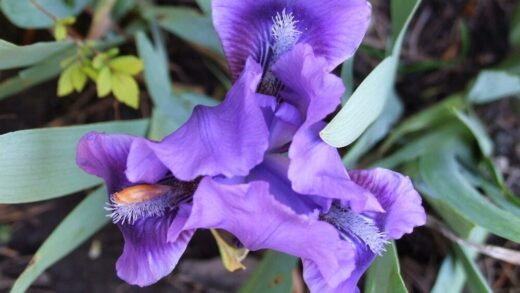Understanding the nuanced water requirements of the dwarf iris is fundamental to its cultivation, as improper irrigation is one of the most common pitfalls for gardeners. These plants have evolved to thrive in conditions that are often drier than the average garden bed, possessing a remarkable tolerance for drought once established. The key to successful watering lies not in providing copious amounts of moisture, but in applying it judiciously and in harmony with the plant’s natural life cycle. Grasping the concept that “less is often more” is the first step toward preventing the fatal issue of rhizome rot and ensuring these irises flourish.
The life cycle of the dwarf iris dictates its fluctuating water needs throughout the seasons. The most critical period for consistent moisture is during the spring, from the moment new growth emerges until the flowering period concludes. During this phase of active growth, the plant is producing foliage, extending flower stems, and developing its vibrant blooms, all of which require a steady supply of water from the soil. If rainfall is infrequent during this time, supplemental watering is necessary to support these energy-intensive processes and ensure the best possible flower display. Without adequate moisture in spring, flowers may be smaller, less numerous, or may fail to develop altogether.
Following the spring spectacle, the water requirements of the dwarf iris change dramatically as it enters its summer dormancy period. This phase is essential for the health of the rhizome, which needs to be in warm, relatively dry soil to cure and to initiate the development of the following year’s flower buds. Continuing to water frequently during the summer months is highly detrimental and is the leading cause of rhizome rot, a fungal disease that turns the rhizome into a soft, foul-smelling mass. For established plants, you should cease all supplemental watering during the summer unless you are experiencing an exceptionally prolonged and severe drought.
The plant’s anatomy itself provides clues to its water needs. The fleshy rhizome is not a root but a modified underground stem that stores water and nutrients, enabling the plant to survive periods of dryness. This storage capability is what makes the dwarf iris so drought-tolerant. The roots that grow from the bottom of the rhizome are responsible for absorbing water and nutrients from the soil. Providing deep, infrequent waterings encourages these roots to grow further down into the soil in search of moisture, creating a more resilient and self-sufficient plant.
Ultimately, the goal of any irrigation strategy for dwarf irises should be to mimic the natural environmental conditions of their native steppe habitats. These regions typically experience moist springs followed by hot, dry summers. By aligning your watering practices with this natural rhythm—providing moisture during the spring growth spurt and then allowing for a dry rest period in the summer—you create the ideal conditions for the plant to complete its life cycle successfully and remain healthy for many years.
Irrigation techniques for optimal health
When you do need to water your dwarf irises, particularly during their active spring growth phase, the technique you use is just as important as the timing. The most effective method is to provide a deep and thorough soaking rather than light, frequent sprinklings. A deep watering encourages the plant to develop a strong, extensive root system that grows downwards into the soil profile. This creates a more resilient plant that is better able to withstand periods of drought, as its roots can access moisture from deeper soil layers that are less prone to drying out.
To achieve a deep soaking, apply water slowly at the base of the plant, allowing it to penetrate the soil gradually without running off the surface. Soaker hoses or drip irrigation systems are ideal for this purpose, as they deliver water directly to the root zone with minimal waste through evaporation. This method also has the significant advantage of keeping the foliage and flowers dry. Wet foliage, especially in the evening, can create a humid microclimate that is conducive to the development and spread of fungal diseases like leaf spot.
You should generally avoid using overhead sprinklers to water your irises. While convenient, this method wets the entire plant, including the delicate blooms and the dense foliage at the base of the plant. This not only increases the risk of fungal diseases but can also damage the flowers themselves. If a sprinkler is your only option, be sure to water early in the morning so that the sun and airflow have ample time to dry the leaves completely before nightfall, which will help to mitigate some of the disease risk.
The frequency of your deep waterings should be determined by observing the soil, not by adhering to a rigid schedule. The best approach is to allow the top two to three inches of soil to dry out completely before you water again. You can check this simply by inserting your finger into the soil near the plant. This “dry-down” period is crucial for allowing air to penetrate the soil and for preventing the constantly saturated conditions that lead to the dreaded rhizome rot.
Watering newly planted irises
Newly planted dwarf iris rhizomes have different and more critical water requirements compared to well-established clumps. During their first growing season, these plants are focused on developing a robust root system to anchor themselves and absorb nutrients. Until this root system is fully formed, they are more vulnerable to drying out. Therefore, they require more consistent monitoring and watering during this crucial establishment phase to ensure they get a strong start.
Immediately after planting, you should give the new rhizomes a thorough watering. This initial soaking is essential for settling the soil around the rhizome and roots, eliminating any air pockets that could cause the roots to dry out. It also provides the immediate moisture needed to signal the plant to break its dormancy and initiate the growth of new roots and foliage. This first watering is a critical step in the planting process that should not be skipped.
For the first few weeks after planting, you will need to check the soil moisture more frequently. A good rule of thumb is to water the new irises whenever the top inch of soil feels dry to the touch. The goal is to keep the soil consistently moist, but not waterlogged. This steady supply of moisture supports the development of new feeder roots, which are vital for the long-term health and survival of the plant. After about six to eight weeks, the plant should have a sufficiently developed root system to be treated as an established plant.
Even after this initial establishment period, you should continue to pay closer attention to your first-year irises throughout their entire first year. They will not yet have the extensive root network or the large, water-storing rhizome of a mature plant, making them slightly less drought-tolerant. A little extra care with watering during their first spring growth cycle and ensuring they do not become completely parched during their first summer will pay dividends in the form of a healthy, vigorous plant ready to put on a beautiful display in its second year.
Adjusting watering based on climate and soil
A successful irrigation plan must be adaptable, taking into account the specific climate of your region and the unique composition of your garden soil. Gardeners in areas with hot, dry climates and low summer rainfall will need to manage water differently than those in cooler, wetter regions. In arid climates, even drought-tolerant plants like dwarf irises may require an occasional deep watering during extreme and prolonged drought in the summer to prevent the rhizomes from desiccating completely, although this should be a rare intervention. Conversely, in regions with ample summer rainfall, the primary challenge is ensuring the soil provides enough drainage to prevent rot.
The type of soil in your garden is a major factor in how you should approach watering. Sandy soils have large particles and do not hold water well, meaning they drain and dry out very quickly. If you have sandy soil, you will likely need to water your irises more frequently during their spring growth phase, as the moisture will not be retained for long. However, this excellent drainage is highly beneficial during the summer dormancy period, as it naturally protects the rhizomes from sitting in wet conditions.
Clay soils, on the other hand, are composed of very fine particles and have a dense structure that retains moisture for extended periods. This can be beneficial in dry climates but poses a significant risk for plants like irises that demand good drainage. If you have clay soil, you must be extremely cautious not to overwater, as the soil can easily become waterlogged, leading to root and rhizome rot. It is crucial to allow for a longer drying period between waterings and to have amended the soil at planting time to improve its structure and porosity.
Ultimately, the best approach is to combine your knowledge of your local climate and soil type with direct observation. Regularly check the moisture level of your soil before deciding to water. Pay attention to weather forecasts; if significant rain is expected, hold off on supplemental watering. By learning to “read” your garden’s specific environment, you can tailor your irrigation practices precisely to the needs of your dwarf irises, providing water when it is beneficial and withholding it when it could be harmful.
Recognizing signs of overwatering and underwatering
Learning to recognize the visual cues of water-related stress in your dwarf irises is a vital skill for maintaining their health. Overwatering is the more dangerous of the two extremes and often presents with symptoms that can be misleading. One of the most common signs is the yellowing of the leaves, starting at the tips and progressing downwards. While yellowing can also be a sign of nutrient deficiency, if it is accompanied by soft, mushy growth at the base of the plant, overwatering is almost certainly the culprit. This indicates that the rhizome is beginning to rot below the soil surface.
Another clear indicator of overwatering is the general lack of vigor and stunted growth. If your irises seem to be struggling, are not increasing in size, or have weak, floppy foliage, it is essential to investigate the conditions at the rhizome level. In severe cases of rhizome rot, you may notice a foul odor emanating from the soil around the plant. If you suspect rot, you may need to gently lift the rhizome to inspect it. A healthy rhizome is firm and white or cream-colored on the inside, while a rotting one will be soft, brown, and foul-smelling.
The signs of underwatering, while less likely in established plants, are more straightforward to diagnose. The most obvious symptom is wilting or drooping of the foliage and flower stems. The leaves may also lose their vibrant green color, appearing dull and grayish, and may develop brown, crispy tips or edges. In prolonged periods of drought, the plant’s growth will be severely stunted, and it may fail to produce flowers altogether as it conserves all its resources for simple survival.
Fortunately, an underwatered iris can usually be revived with a thorough, deep soaking. The plant should begin to recover and look more turgid within a few hours. However, it is important to address the issue before it becomes severe, as extreme water stress can weaken the plant and make it more susceptible to pests and diseases. By regularly observing your plants and checking the soil moisture, you can learn to distinguish between the signs of too much and too little water and intervene appropriately before any lasting damage is done.
📷 Jerzy Opioła, CC BY-SA 4.0, via Wikimedia Commons


















